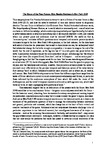The Genre of the Near Future: Kim Stanley Robinson's New York 2140
| dc.contributor.author | Sergeant, David | |
| dc.date.accessioned | 2018-11-06T11:41:57Z | |
| dc.date.issued | 2019-04-01 | |
| dc.identifier.issn | 0016-6928 | |
| dc.identifier.issn | 2160-0228 | |
| dc.identifier.uri | http://hdl.handle.net/10026.1/12723 | |
| dc.description.abstract |
This essay explores Kim Stanley Robinson’s fiction of the near future, New York 2140 (2017) and how its treatment of time and history relates to its generic identity. By imbricating present and future, New York 2140 resembles not so much science fiction, the genre commonly associated with the future, as the historical novel, inheriting from its nineteenth-century exemplars and moving beyond its postmodern incarnations. New York 2140 also proves innovative in its treatment of the relationship between individual and general, particular and universal, which has always been central to critical and creative treatments of the historical novel. Robinson’s text shows that this scalar challenge is of particular importance to the contemporary moment and reconfigures how some of its major coordinates — the economy, the environment, the body, and narrative itself — cross the gap between micro and macro. In doing so, however, it draws heavily on allegory, and this not only recalls the problems that allegory has posed to previous critical treatments of the historical novel but also suggests why New York 2140 is an outlier in near future fiction. Instead, the novel might be situated alongside cross-disciplinary texts by Naomi Klein, David Harvey, and Bill Mc Kibben that Robinson calls “utopian nonfiction.” | |
| dc.format.extent | 1-23 | |
| dc.language | en | |
| dc.language.iso | en | |
| dc.publisher | Duke University Press | |
| dc.subject | Biotechnology | |
| dc.title | The Genre of the Near Future: Kim Stanley Robinson's New York 2140 | |
| dc.type | journal-article | |
| dc.type | Review | |
| dc.type | Journal | |
| plymouth.issue | 1 | |
| plymouth.volume | 52 | |
| plymouth.publication-status | Published | |
| plymouth.journal | Genre | |
| dc.identifier.doi | 10.1215/00166928-7500990 | |
| plymouth.organisational-group | /Plymouth | |
| plymouth.organisational-group | /Plymouth/Faculty of Arts, Humanities and Business | |
| plymouth.organisational-group | /Plymouth/REF 2021 Researchers by UoA | |
| plymouth.organisational-group | /Plymouth/REF 2021 Researchers by UoA/UoA27 English Language and Literature | |
| plymouth.organisational-group | /Plymouth/Users by role | |
| plymouth.organisational-group | /Plymouth/Users by role/Academics | |
| plymouth.organisational-group | /Plymouth/Users by role/Researchers in ResearchFish submission | |
| dcterms.dateAccepted | 2018-09-16 | |
| dc.rights.embargodate | 2019-9-18 | |
| dc.identifier.eissn | 2160-0228 | |
| dc.rights.embargoperiod | Not known | |
| rioxxterms.versionofrecord | 10.1215/00166928-7500990 | |
| rioxxterms.licenseref.uri | http://www.rioxx.net/licenses/all-rights-reserved | |
| rioxxterms.licenseref.startdate | 2019-04-01 | |
| rioxxterms.type | Journal Article/Review | |
| plymouth.funder | Imagining Alternatives: Utopia, Community and the Novel, 1880-2015::AHRC |


